Fusion technology today relies on expensive, building-sized equipment for ignition, or the help of an already powerful fission detonation. What if we could do away with both?
Fusion power without the need for fissiles, but also small enough to be launched into space. It is possible, and eventually it will be practical. Let’s look at how that would work and its implications.
The lead image is artwork commissioned from the talented Daemoria on the ToughSF Discord. It features a spacecraft powered by an Orion-type nuclear pulse propulsion system refueling using the ices of an asteroid deep in the Outer Solar System. Click to zoom in!
Too big to launch
 |
| The point of convergence of all the National Ignition Facility's 192 lasers. |
Fusion research today focuses on igniting small quantities of deuterium and tritium using the concentrated energy of lasers, magnetic fields, plasma jets or particle beams. This puts the fuel in conditions far more intense than the core of our Sun, which is enough to ignite the nuclear reaction. However, the total amount of energy being handled is not all that great.
The latest record-breaking fusion attempt at the National Ignition Facility added 1.8 MegaJoules of energy in the form of a laser pulse to a tiny gold Hohlraum containing a few milligrams of frozen fuel. Only 150 kiloJoules was actually absorbed by the fuel. From this, the fusion fuel yielded 1.3 MJ, or 8.6 times the input.
The energies involved here are equivalent to the kinetic energy of a small truck at highway speeds or the heat released by burning about 50 milliliters of gasoline. Even if we include the total electrical input of the NIF facility during the attempt, 422 MJ (mainly due to the ridiculously low 0.8% efficiency of the lasers), then we are talking about equivalent to the kinetic energy of a medium-sized passenger jet on takeoff or the explosives in a Mark 82 bomb. It is more than we usually encounter in everyday life, but within reach with a little effort.
 |
| The full NIF facility houses 7680 xenon flash lamps and 3072 glass slab lasers. |
So how do we move fusion technology into space?
Stars in small boxes
There is an easy path and a hard path to placing fusion technology in space.
 |
| This design pushes 50 tons of payload to Mars using a 1.2 GW fusion drive. |
A single Starship launch of 100 tons would be able to deliver a reactor with an output of 1 GigaWatt if fusion technology achieved that performance. That’s enough to tend to the needs of over a million people.
However, these advances are a long way away. It will require immense effort and research investment over the course of several decades to even come close to these figures.
What about the easy path?
 |
| The 15 Megaton yield Castle Bravo test. |
Fusion reactions have been produced easily and in small packages since the 1950s in thermonuclear bombs. The shortcut here is to create the necessary conditions for igniting fusion fuel using the awesome power of another nuclear reaction: fission. It is much easier to extract energy from unstable uranium or plutonium isotopes. It can be as simple as bringing enough of these substances together in one place.
The only challenge that remains is to channel that energy into the fusion fuel - an idea first proposed by Enrico Fermi that resulted in the Teller-Ulam design that used the radiation from a fission stage (the primary) to implode a fusion stage (the secondary). From a physics perspective, it is very elegant: it turns a hard problem (igniting fusion) into two easy problems (igniting fission, then transferring the energy).
From a practical perspective, it is terrifying. Any plane or rocket that could lift a few hundred kilograms had its destructive capability upgraded to levelling an entire city. The W56 warhead weighs only 272 kg but manages a yield of 1.2 million tons (megatons) of TNT.
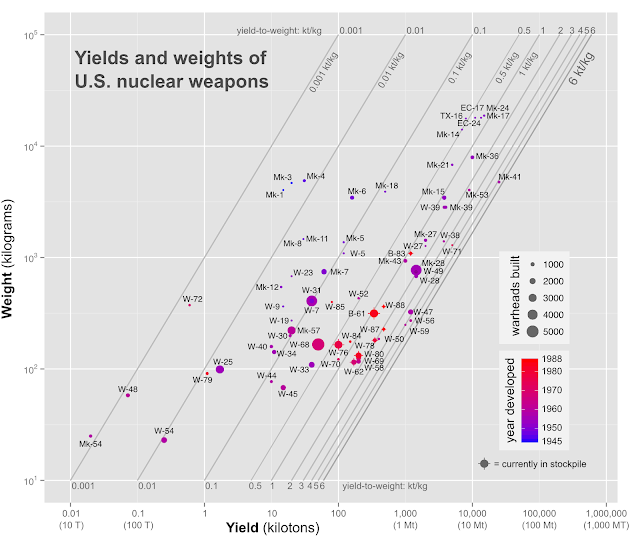 |
| The incredible yield-to-weight ratios of nuclear warheads. |
ICBMs have carried these thermonuclear warheads into space, but not into orbit. These missiles cannot achieve orbital velocity, but only because it is not necessary and not because it is impossible. Their deltaV capability is about 6 to 7 km/s and they would need an additional stage to achieve the necessary 9 km/s for Low Earth Orbit. Incidentally, this is how we got the Soyuz rocket; by adding an extra stage to the R-7 ICBM.
Thermonuclear weapons have been tested in space. The most famous example is the Starfish Prime shot. A W49 warhead with a yield of 1.4 megatons was detonated at an altitude of 400 km.
.jpg) |
| The Starfish Prime test of 1962. |
A naïve calculation would find that a SpaceX Starship could be filled with W56 warheads and hold a combined yield equivalent to 441 megatons of TNT. The previous 1 GW reactor would have to work for 58 years to match the energy these warheads could release in microseconds.
It is not so straightforward though.
Thermonuclear warheads have many downsides that prevent them from being an acceptable fusion technology in space.
The first is their minimum size. The fusion reaction must be initiated by a fission reaction, which requires a critical mass of fissile material. In the smallest warheads, this is brought down to a few kilograms, resulting in a minimum yield of roughly 42 GJ or 10 tons of TNT. A warhead at this scale is extremely wasteful in its use of fissile material. The smallest design that actually liberates a good fraction of its potential energy would release 4,200 GJ or 1000 tons of TNT. Funnily enough, it obtains this from the same amount of fissile material but with a much larger and more complex compression scheme. A fusion stage on top would need to release a multiple of this yield (10 to 20 times more) to be worth its inclusion.
A propulsion system that uses thermonuclear bombs would have trouble if it were hammered by pulses with a yield equivalent to tens of thousands of tons of TNT. A nozzle or pusher plate that receives this blast would be immense, and the suspension system needed to translate the pulses into a continuous acceleration would bring us back to the building-sized equipment we are trying to avoid in the first place.
The second is their need for fissile material. It is in fact the biggest problem with producing thermonuclear warheads. Today, it means that they need a highly controlled substance, which is enriched uranium or plutonium. It is expensive, difficult to manufacture, easily weaponizable and dangerous if accidentally dispersed. Political considerations and social fears have already prevented the launch of much milder nuclear propulsion system, in the form of Nuclear Thermal Rockets, and ruled out designs like the Orion nuclear pulse propulsion rocket by international law.
Even in a fictional setting or alternate-future where these concerns are minimized, there is still the logistical problem of sustaining the use of these materials.
 |
| The Midnite mine. |
Uranium is only found in high concentrations on Earth thanks to the action of the terrestrial water cycle. Dry surfaces like the Moon or small bodies like asteroids have their uranium dispersed within them at concentrations similar to the primordial composition of our Solar System. Instead of mining rich veins for uranium at 200,000 parts per million, settlers on Venus or Ceres would be sifting through vast quantities of rock to extract less than 2 parts per million.
 |
| Map of uranium on the Moon. |
That’s 5 grams per cubic meter of rock. Worse, only 0.7% of this uranium is of the desired U235 isotope, so only 35 milligrams of enriched material would go towards the thermonuclear warhead. The rest would have to go through a laborious burnup and transmutation process inside breeder reactors.
If the minimum critical mass is about 2 kilograms, then over 57,000m^3 of rock would need to be processed for each thermonuclear pulse. A rocket that uses these pulses for propulsion may need thousands of pulse units to complete a trip… it is clearly unsustainable!
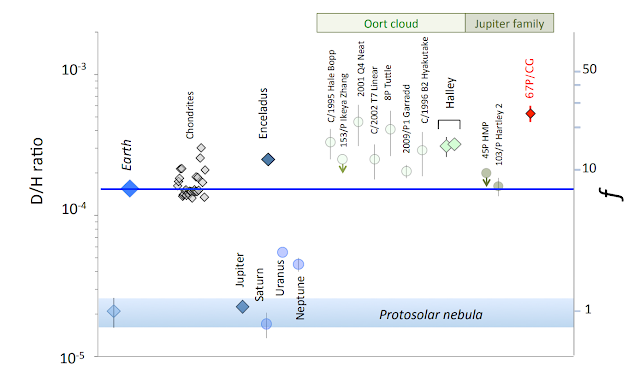 |
| Deuterium/Hydrogen ratios in the Solar System |
The fusion fuel is a minor concern in comparison. Deuterium is abundant in all waters of the solar system at 312 parts per million (0.312 grams per kg), and can be higher in the outer solar system. Deuterium concentration was 3 times higher in the samples returned from the comet 67P/Churyumov-Gerasimenko than on Earth. It can be melted out of the ices of a comet and separated by electrolysis. Tritium is trickier to obtain, but it can be manufactured out of lithium, which is a rather common element. It decays with a half-life of 12 years but with the speed of fusion propulsion, most trips will be completed well before then.
Helium 3 is very rare in comparison, but obtaining it is still possible from the lunar surface or by scooping up the atmospheres of Venus or the gas giants. Filtering gases is a much easier task than digging through kilometers of rock after all.
Going by the abundance of their fuels, we would want to use Deuterium-Deuterium fusion, then Deuterium-Tritium, then Deuterium-Helium 3.
Pure Fusion
 |
| A hemispherical implosion test device. |
The solution is to find a way to use a simple non-nuclear energy source, and concentrate it in a way that can ignite a fusion reaction but without the need for complex or heavy machinery to serve as an intermediary. Fusion, without the ‘dirty’ fissile aspect.
This is the ‘pure fusion’ concept that has long been on the minds of scientists since the first fusion bomb was tested. It found renewed interest ahead of and following the Comprehensive Test Ban Treaty in 1996. Some of the methods for achieving pure fusion ignition, especially by Soviet and then Russian scientists, were tested in the 1990s and 2000s in collaboration with LANL. It might be because they feared that they might not have access to the multiple billion dollar investment needed to pursue conventional ignition research. More recent concepts have appeared too. Interest in them has waned since fusion research has become a well funded international effort, like JET and NIF.
.jpg) |
| 'The Gadget' from the Manhattan project. |
This is a prickly topic to discuss with any nuclear scientist today. The design of a pure fusion device overlaps significantly with that of a regular nuclear warhead. Discussing this topic in detail with the general public generally goes against the rules they have to follow to retain their security clearances. They might inadvertently reveal facts or figures they are not allowed to share, even for far off speculation like this. It is wise to not test their patience.
Nuclear weapons after all threaten human civilization on one hand, and offer absolute protection against invasion or loss of sovereignty on the other. Aggressive posturing by small and otherwise weak states like North Korea is only possible because they have incredible destructive power at their disposal. The proliferation of nuclear weapons weakens the protection they offer to existing holders while increasing the risk that they are deployed by someone who doesn’t have much to lose. Anything that threatens to share nuclear power to a wider group is therefore taken very seriously.
Pure fusion technology could be considered to be one such proliferation concern. The creation of nuclear weapons that circumvent the most effective anti-proliferation control, which is access to fissile material, could destabilize the relations between nuclear states. Global annihilation would come closer. More specifically, it is a restriction on the enrichment of uranium from 99.3% U238 into >90% U235 (or into Pu239).
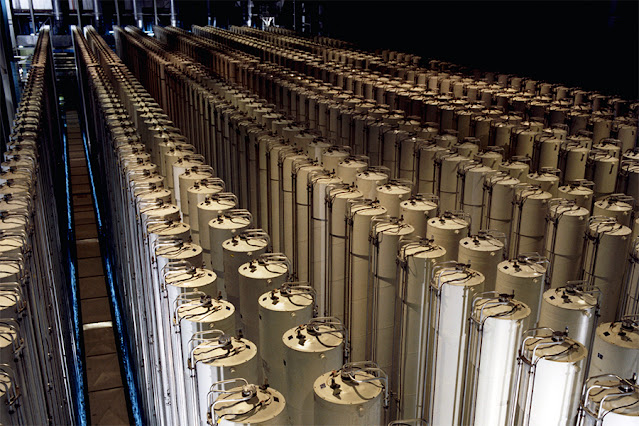 |
| Uranium gas centrifuges for U235 enrichment. |
Natural uranium cannot be made into a bomb, and it is regularly shipped around the world by the hundreds of tons to feed nuclear reactors. It would be practically impossible to restrict access to it. ‘Reactor grade’ uranium, which is enriched to less than 5% U235, won’t work either. Climbing up to ‘weapons grade’ is a long and arduous process that requires gas centrifuges that take up several football fields and many megawatts of electricity. The machinery is delicate and needs trained personnel to run… even moderate damage or a cyber attack can take them down.
 |
| India's Bhabha Atomic Research Centre reactor. |
The other route, which is to operate a reactor specifically designed to produce Plutonium 239, is also difficult to hide, but it has been successful in the past.
Pure fusion ignition does not need enriched uranium. There is discussion around how the technology could destabilize the current nuclear arms balance, especially since the Comprehensive Test Ban Treaty left open the door to conventional ignition research and therefore there is a legal ground for the development of alternate ignition schemes. However, as we will calculate later, pure fusion devices cannot result in weapons with the same destructive potential as actual nuclear warheads. They might have an effect on warfare at the tactical scale but not really at the strategic level.
Still, there is a real possibility that these designs will be developed seriously in the future, for military purposes or not. They have advantages that are not useful today but might be critical for a space settlement at the edge of the Solar System. Looking into these pure fusion concepts can help inform us about their future potential in propulsion, energy generation and elsewhere.
We will look at two plausible concepts for igniting a pure fusion device.
The first is Magnetized Target Fusion using explosive-driven flux generators.
The second is Multi-Stage High Explosive-driven Implosion Fusion.
To these documented concepts we will add invented variants based on other speculative technologies that have been demonstrated in some way or another.
Magnetized Target Fusion using Explosive-driven Flux Generators
 |
| A helical explosive-driven flux generator design for the MAGO experiments. |
Explosive-driven Flux Generators are able to convert the chemical potential of a high explosive (HE) into a powerful magnetic pulse. This is done by first creating a strong magnetic field by running an electrical current from a small capacitor through a number of conducting disks (Disk Explosive Magnetic Generator or DEMG) or coils (Helical Explosive Magnetic Generator or HEMG). The detonation of a high explosive compresses these conducting structures into a smaller and smaller volume, which magnifies the electrical current and multiplies the initial magnetic field to several hundred tesla. These steps can be staged, with the magnetic field produced by the first compression being multiplied again by a second compression.
 |
| The Tsar Bomba was developed at the Russian VNIIEF. |
Experiments at the Russian VNIIEF (All-Russian Scientific Research Institute of Experimental Physics) demonstrated a 20 to 25% conversion of high explosive energy into magnetic energy, with electrical currents on the order of 100 MegaAmperes producing magnetic fields of 200 Tesla strength. It should be noted that actual efficiency is likely much higher (1.5x times higher, so in the 30-40% range) but only a fraction of the total output is delivered at a useful rate, as explained in the Efficiencies section in this document. There is also an explanation that these results are from designs that did not really require high explosive-to-magnetic efficiency, and that instead of 70% is possible with end-initiated coaxial generators.
A DEMG with 3 modules, containing disks a meter wide, was shown to deliver 100 MJ of energy and an electrical current of 256 MA, and it is possible to stack 25 of these modules and maybe more.
 |
| DEMGs tested at the VNIIEF. |
These powerful magnetic pulses can be used to drive Magnetized Target Fusion (MTF).
In this ignition scheme, fusion fuel is first heated into a ‘warm’ plasma, and then it is rapidly compressed by imploding a spherical metal shell (the liner). The shell implodes because of the powerful magnetic pulse we have created using a flux generator. It achieves a substantial velocity of several tens of kilometers per second, enough to raise the pressure and temperature of the plasma trapped inside to fusion ignition conditions. Almost all the fusion energy that is then released is absorbed by the metal shell, causing it to vaporize and expand as a plasma explosion, which can be redirected for thrust or absorbed to generate electricity.
MTF has been demonstrated successfully several times with actual fusion neutrons being detected. The biggest current project aiming to use MTF is General Fusion.
 |
| General Fusion's piston-compressed MTF scheme. |
It has many advantages over achieving fusion using conventional means. The pressure it can achieve far exceeds anything a tokamak can manage by using static (non-pulsed) magnetic fields, which really helps push fusion fuel particles together. The implosion velocity is much lower than the several hundreds of km/s that need to be achieved at the NIF or most other inertial confinement fusion schemes and it receives that energy far more efficiently than could be managed by a laser or particle beam blasting away at a pellet of frozen fusion fuel.
However, it has its own set of challenges and far less investment in its development than the other ignition methods.
Each arrow has a certain efficiency figure associated with it. The only source of energy input is the high explosive, and the only source of energy output is from the fusion reaction. There are some small steps we are omitting here, like losses to electrical switching or the initial heating of the fusion fuel, but they are far smaller (kJ scale) than the energies involved in the main steps (MJ scale). The objective is to have a far greater fusion output than the HE energy input.
 |
| The MAGO plasma chamber. |
The VNIIEF’s MAGO project (MAGnitnoye Obzhatiye or magnetic compression) found that if the metal liner had a kinetic energy of 65 MJ and imploded at 20 km/s, it could get 8.9 milligrams of deuterium-tritium plasma pre-heated to 1 million Kelvin to undergo fusion and release 1 GJ of energy. Deuterium-Tritium reactions have an output of 340 TeraJoules per kilogram. The full potential of the 8.9 milligrams of fuel is 3.03 GJ. This means that the implosion got 33% of the fuel to undergo fusion (also called the burnup ratio). The result is a ‘fusion gain’ of 16x. They based these results on experiments with 200 MJ flux generators creating >1000 Tesla fields adding up to 25 MJ into the metal liners.
If we assume that 25% of the high explosive’s energy can be converted into magnetic energy, and that 60% of the magnetic HE is around 5 MJ/kg for denser compositions like ‘PBX 9501’, so working backwards, it would take 86.6 kg of HE to deliver 433 MJ as energy input, that gets converted into 108.25 MJ of magnetic energy, which results in 65 MJ of metal liner kinetic energy. The final output is 1000 MJ, giving a return on energy investment of 2.3 times.
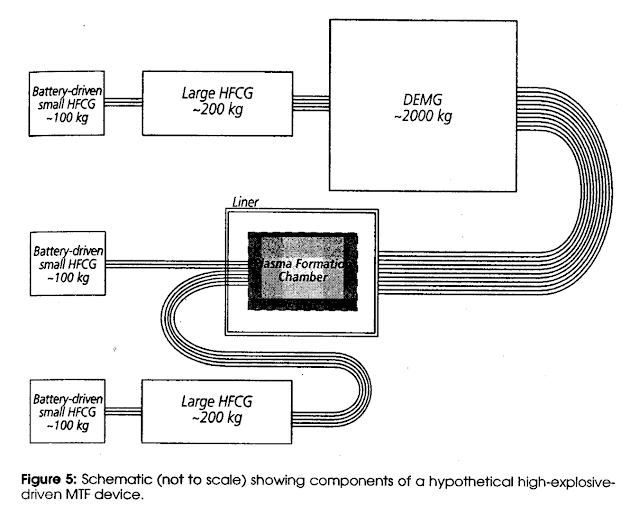 |
| Component weights for a DEMG-powered pure fusion device. |
Other estimates in this document’s appendix B suggest that a multi-stage device with a plasma chamber would fit 320 kg of HE inside 3400 kg of equipment to be able to deliver 100 MJ to a metal liner that compresses up to 30 milligrams of DT fuel. The fusion output is 10 GJ, which is a 33% burnup ratio. The performance of the flux generators is pessimistic, with only 6% of the 1600 MJ chemical potential in the HE actually being delivered to the plasma chamber. That means a return on energy investment of 6.25 times. The majority of the mass is dedicated to a 2000 kg DEMG device. In the footnotes, it is explained as a necessarily conservative estimate, far greater than the minimum amount of copper wires needed for simply conducting the electrical current. In fact, it seems like the masses of all the explosive flux generators have been estimated by multiplying the mass of the explosive they contain by a factor 10.
There are few other figures to rely upon for further speculation.
Nonetheless, we can put together the data we have to obtain a ‘reasonable’ MTF design that is powered by high explosives. We’ll call this the Early EMG-MTF device.
This design is admittedly not very powerful. 2.52 GJ of fusion output might sound like a lot, but it is only a 5 times return on energy invested. It is also important to look at the average energy density of the device. It is much less powerful than the same mass of simple HE, so it would be a terrible weapon and even worse propulsion system - for comparison, a mixture of hydrogen and oxygen in a rocket engine has an average energy density of 15 MJ/kg. It actually compares poorly to lithium-ion batteries, which is laughable for a thermonuclear reaction.
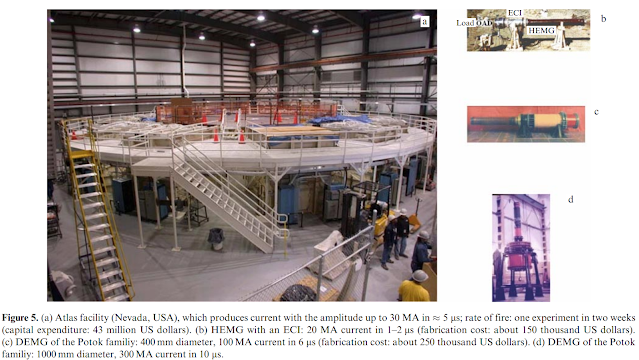 |
| Comparison of the huge structures need to provide an electrical pulse with capacitors or high explosives. |
Technology is expected to improve. If we conceived of this technology today instead of in 1998, we should hope to get better results. This can include the use of stronger materials, aluminium conductors instead of copper wires or even high temperature superconductors, better HE compositions and perhaps a different explosive flux generator design that comes closer to the 70% HE-to-magnetic efficiency mentioned previously. These would all lead to a lighter device. It is unlikely to fall below 2x the weight of the explosives, because the HE needs to push against something to transfer its momentum efficiently, but a reduction from 10x to 5x the weight is plausible.
 |
| More explosive flux generator configurations. |
Today’s MTF schemes also aim for much higher fusion gain ratios. Tricks to improve the efficiency of the reaction, such as turning the initial warm fuel plasma into a field reversed configuration that is self-containing and prevents heat losses by touching the imploding metal liner too early, can be used.
General Fusion’s initial Acoustic MTF concept had pistons compressing a plasma, with 14 MJ being delivered to the plasma in the final step. This was enough to release 704 MJ of fusion energy, which is a fusion gain of 50 times. We can work out that they use 10 milligrams of fusion fuel with each shot, and that the burnup ratio they assume is 20%.
 |
| The Fusion Driven Rocket's magneto-inertial ignition concept. |
John Slough’s Fusion-Driven Rocket uses a type of Magnetized Target Fusion where the metal liner is made of lithium and receives a kinetic energy of 2.8 MJ. In return, it provides a fusion gain of 200. This is far above the fusion gains mentioned previously. There are hotspot ignition schemes that can attain fusion gain ratios in the thousands by starting a burn wave in a much larger quantity of fuel, but let’s not be excessively optimistic.
If we assume that these promises will be fulfilled, then we can guess at the performance of an EMG-MTF built to an advanced technology standard.
We get a much more interesting device. It is 6.7 times more powerful than HE on its own and exceeds the performance of any chemical reaction. But even these improved figures are nowhere near the power of a conventional nuclear warhead which manages energy densities on the order of 10,000,000 MJ/kg.
Multi-Stage High Explosive-driven Implosion Fusion
 |
| The UTIAS explosive-drive implosion of a hemispherical chamber. |
However, some ignition schemes get around this by concentrating the energy of the high explosive shockwaves in some manner. This was demonstrated by using a Voitenko compressor to send a shockwave into a hemispherical chamber filled with deuterium gas. Fusion neutron were successfully produced and detected.
 |
| The theoretically simple collapsing spherical chamber. |
Even more effective (in theory) is use explosives to surround a 1m wide sphere of metal and get it to implode into a tiny 0.1 cm-sized volume. This 1000x decrease in volume would bring the initial inward velocity to several thousand km/s and multiply the internal pressure by tens of millions of times, enough to ignite a fusion reaction.
Tests have successfully demonstrated 1 MJ-scale detonations imploding metal spheres and hemispheres and causing some fusion reactions to occur. However, they used 20 cm wide spheres and tried to explain how scaling up their designs will not provide much improvement.
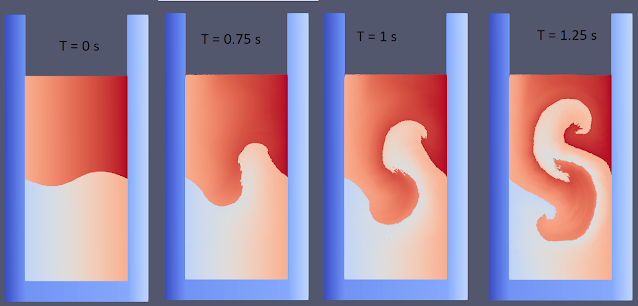 |
| Rayleigh-Taylor instabilities forming. |
The tiniest imperfections in the sphere or the explosive would be magnified as the sphere’s size decreases and would cause the compression to fail. Rayleigh–Taylor instabilities would also cause the smooth surface of the metal sphere to bubble over into a turbulent storm that isn’t very effective at compression fusion fuel. Mitigating these imperfections involves scaling up the sphere to tens of meters in width, and therefore surrounding it with thousands of tons of HE. Not a great solution either.
Instead, what we could do is perform a more moderate implosion, and then convert the energy into another form that can do more work on compressing the fusion fuel.
Two methods are documented.
 |
| Winterberg's magnetic booster concept. |
The most complicated method involves the use of a ‘magnetic booster’. The metal sphere that the HE will implode is given an electrical current, which produces a magnetic field. The sphere is also filled with low density fusion fuel in the form of a gas and at its center is a special target.
The initial implosion takes place at a velocity of 5 to 8 km/s, depending on the initial size of the metal sphere. Near the end, the walls are closing in at over 20 km/s. This is enough to raise the temperature within the fuel gas to millions of Kelvin. Not enough for ignition, but enough to get the special target to work. The implosion also multiplies the initial magnetic field into something of massive strength.
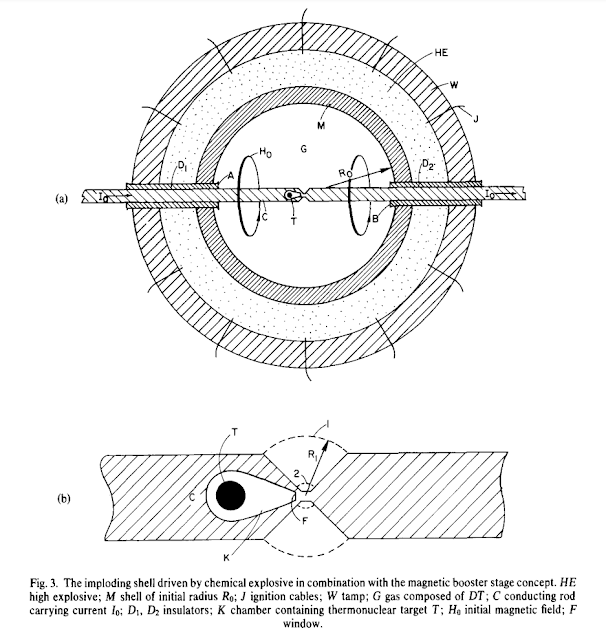 |
| A diagram of this mag-booster concept. |
The special target is the magnetic booster and a fuel pellet surrounded by ablative material in a small closed chamber next to it. The magnetic booster is a Z-pinch device, basically a number of coils connected to a capacitor and surrounding a conductive tube. The circuit is open, so there is no electrical current. At the final stage of the metal sphere’s implosion, the circuit is closed. Current runs through the coils and creates a small magnetic field. This does nothing on its own, but it does react to the massively strong magnetic field that surrounds it. The interaction of the fields causes a similarly massive electrical current to start running through the conductive tube. This causes the Z-pinch effect, which exerts enormous pressure on the tube and causes it to collapse.
This collapse causes the remains of the tube to radiate heat. This comes in the form of energetic UV and X-rays. Penetrating radiation digs into the adjacent chamber that has held the fuel pellet safe so far. The ablative layer surrounding the fuel pellet vaporizes. The reaction force of the vaporized gases forces the fuel pellet inwards, in turn bringing it to fusion ignition conditions.
You may have noticed the similarities between this ‘magnetic booster’ and the steps taken by the Teller-Ulam design of a thermonuclear warhead to turn the energy released by a fission primary into X-rays that then cause a fusion secondary to implode and ignite.
The ignition of the tiny fuel pellet raises the temperature of all the gases compressed within the metal sphere. It creates a much larger fusion reaction, which could then be used to ignite even larger quantities of fusion fuel… if we were not tired yet of the great complexity and number of steps involved so far.
 |
| The complete propulsion system. |
Winterburg gives us some estimates for the performance of this pure fusion device. It would be a 20 cm wide metal sphere, about a millimeter thick and weighing 40 kg, surrounded by a 10 cm thick layer of HE. The explosive is assumed to be Octol, which has a density of 1700 kg/m^3 and an energy density of 5.3 MJ/kg. This layer is itself contained inside a 10 cm thick iron sphere (the tamper) that weighs 800 kg. The iron is the single biggest contributor to the device’s mass. Its job is to contain the 70 MJ high explosive detonation for a maximally efficient implosion.
The total mass of the device is 853 kg, rounded up to 1000 kg by Winterberg. The fusion reaction within it releases 400 GJ of energy. Most of it is in the form of neutrons, but the iron sphere does an excellent job at absorbing them all. We can call it the Magnetic Booster Implosion Fusion device or MBIF. Here is the summary:
This is an incredible performance, blowing away even the best assumptions for the Advanced EMG-MTF. We can attribute this to the much larger quantity of fuel that gets heated to ignition conditions and the elimination of the heavy flux-generator equipment. Still, this is nowhere near the power of a conventional nuclear warhead.
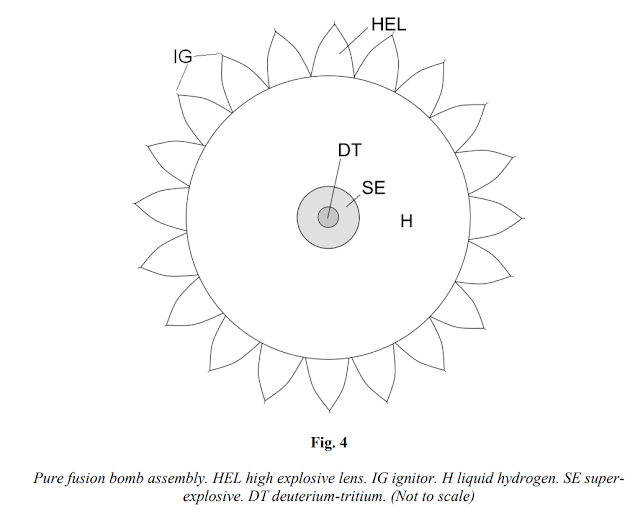 |
| A Winterberg pure fusion design, this time relying on compressed 'super-explosives'. |
Winterberg’s original conception of a ‘mini-nuke’ had a metal sphere collapsing to the point where it radiates in the X-ray wavelengths and causes another ablative stage to compress fusion fuel to the point of ignition, without the need for a complex ‘magnetic booster’. It might reduce the number of steps needed to achieve fusion, at the cost of tightened tolerances on how smooth the metal sphere is and how evenly the HE detonates. These advantages would be seen during the manufacturing stage and not in the actual performance.
Another method attempts to improve on the design offered by Winterberg but combining it with more recent techniques.
Finn van Donkelaar suggests that a staged HE accelerator using overdriven detonations can do away with the imploding spheres and heavy iron tamper. It is a less rigorous treatment of the topic, but it does have some interesting figures to offer. There are four steps: acceleration of metal plates (flyers), piston-compression of deuterium-tritium gas followed by a spherical implosion, and finally a fuel pellet surrounded by ablative material that undergoes the final compression.
 |
| The same principles as those for creating EFPs are used here. |
The HE is separated into disks lined up behind metal plates (called flyers). The first HE stage is ignited and it pushes a flyer to 3 km/s. This flyer hits the back of the second stage, creating a shockwave. This second stage adds its own velocity to its own flyer, allowing for flyer velocities greater than what is possible with a single stage - a solution very similar to one adopted by rockets to overcome the deltaV limitations of a single stage.
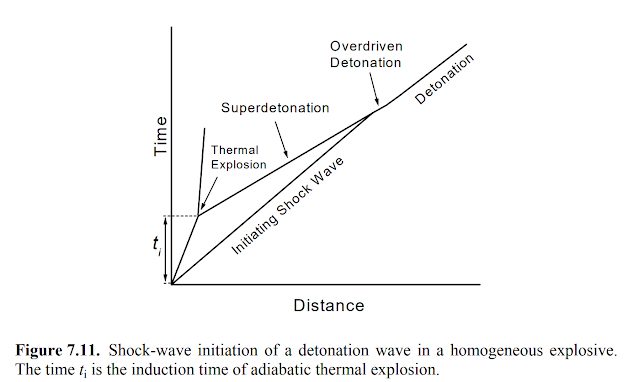 |
| Explosives act differently when compressed due to a shockwave. |
The shockwave has an additional effect. It causes a sudden compression of the material it passes through. Compressed matter has a higher density and therefore a greater speed of sound. The compression also causes the chemical composition to ignite. Theoretically, the travelling wave will pick up more energy from this combustion, causing it to compress more HE even harder, which again increases the speed of sound and allows it to reach higher velocities. The result is an 'overdriven' detonation velocity superior to the ordinary uncompressed detonation velocity.
The combined effects of staging and overdriven explosion velocity would allow flyer plates to achieve 8-12 km/s.
The final flyer hits a converging section that focuses its energy on a ‘cup’. That cup acts like a piston travelling down a tube that contains DT gas before meeting a ‘bowl’. The temperature at this point has increased to 9500 K. The cup and bowl then meet to form a sphere that undergoes its own implosion that forces the fusion fuel into a volume a thousand times smaller. Temperatures reach millions of Kelvin, providing the X-ray radiation needed to make the surface of the fuel pellet surrounded by ablative material explode and finally achieve ignition. The fusion reaction in the fuel pellet provides the spark that gets the rest of the fuel gas to react.
We have some performance figures, but with few details. A scaled up device would mass 1600 kg in total, have a length of 2.5m and a width of 0.4m, and yield an output of 8,368,000 MJ. Energy density is 5,230 MJ/kg. The amount of fusion fuel consumed is between 50 and 100 grams, depending on assumptions about burnup ratio. We can call it the Staged Overdriven Accelerator Fusion device.
This performance figure is ridiculously high, and it speaks to the true potential of fusion technology. And yet, it is about 1900 times weaker than a thermonuclear warhead.
Other ways to spark the fire
There are even more ways to get fusion reactions without needing any fissile material or heavy equipment. They are, however, even more speculative.
 |
| A SMES device using niobium-tin coils. |
One example is to use Superconducting Magnetic Energy Storage (SMES) devices. SMESs pushed to the limits of the tensile strength of the materials holding them together can manage impressive energy densities. The quenching process allows them to release their stored energy nearly instantaneously too. Using the maximum strength-to-weight ratio of modern mass-produced materials, such as the 7 GPa strength at 1790 kg/m^3 density of Toray T1100G carbon fibers, would be able to store 3.9 MJ/kg.
This is less energy than the 5 MJ/kg of dense explosives like RDX. However, SMES output their energy in the form of electricity, allowing it to be converted into magnetic energy with near-perfect efficiency, and at extremely rapid rates. They also greatly reduce the mass of copper conductors and various magnetic coils needed as they can pass huge currents through small wires (assuming the wires are also superconductors). In effect, 1 kg of Toray 1100G-backed SMES is worth 1.4 to 3.1 kg of HE due to increased efficiency. It would be even better in practice as SMES do not need to explode or push against something to operate (so no need for a heavy tamper), so they can allow for even greater mass savings. At their best, SMES backed by more advanced materials, such as carbon nanomaterials, could exceed 50 MJ/kg while retaining the efficiency benefits over HE. Superconducting materials applied to other parts of an explosive flux generator could result in the following device:
This would bring it more in line with the performance of the staged HE accelerator. Of course, applying SMES technology to the SOAF device itself would bring performance to an even greater level.
 |
| Simulation of a shear-flow-stabilized Z-pinch, one of the most promising approaches. |
There are even more ways to use the energy of a large explosion. The flux generators could exploit their ability to produce electrical currents in the hundreds of mega-amperes to drive a large Z-pinch. This could be used to directly compress a metal liner around a fuel pellet, as in the HOPE Fusion propulsion approach (an MTF version was also designed). In that design, 333 MJ is delivered to the specially shaped fuel target, and in return, 1 GJ of fusion energy is released. This energy gain ratio of just 3x is too slim to work with HE, but an improved concept could allow it.
 |
| An explosive-driven railgun. |
Or, the electrical current could be used to power a short but extremely high acceleration electromagnetic gun. It would be connected by long wires to the EMG so the debris from its remains do not damage the accelerator. Whether it is a coilgun or a railgun, a projectile velocity of 20 km/s could be achieved before the current falls off. This is enough to start the multi-staged compression cycle proposed here for low velocity fusion ignition. It would be even easier to use the electrical discharge from SMES, although that raises the difficult question between throwing away empty SMES or installing the equipment to recharge them.
The Wilderness Orion
The application that stands out the most for these pure fusion devices is in the domain of space propulsion.
A pure fusion device could be used to create a large plasma explosion. A magnetic nozzle or pusher plate could be used to turn that fusion energy into thrust, similarly to the various nuclear pulse propulsion designs.
To estimate the performance of these devices as rockets, we use the method described in a previous blog post. This equation is most useful:
Plasma RMS velocity = (2 * Energy Density)^0.5
We can turn this into an exhaust velocity by including an efficiency figure for how good a nozzle is at turning an expanding plasma into an exhaust stream.
Exhaust velocity = Nozzle efficiency * (2 * Energy Density)^0.5
The energy density we use here is that of the entire device. This is because we must assume that the fusion reaction and its X-rays, charged particles, neutrons and other products are all fully absorbed into the device’s mass and converted into heat.
For the Early EMG-MTF design, we get Energy Density = 1,570,000 J/kg. With a nozzle efficiency of 90%, we calculate an exhaust velocity of 1594 m/s. That’s a specific impulse (Isp, or exhaust velocity divided by 9.81) of 162 seconds, which is worse than most cold gas thrusters. No spaceship is going to bother with that.
The Advanced EMG-MTF and its 33.66 MJ/kg is much more interesting. We calculate an exhaust velocity of 7384 m/s. That’s an Isp of 752s. This is better than any chemical thruster and comparable to a low performance solid-core nuclear thermal rocket or a solar thermal thruster restricted by poor materials.
The Winterberg MBIF manages 400 MJ/kg. That results in an exhaust velocity of 25,455 m/s. An Isp of nearly 2600s is better than most high-thrust electric thrusters and is only matched by advanced gas-core nuclear rockets.
Performance reaches another level once energy density is measured in GJ/kg. The SMES-EMG-MTF would get us 5,200s Isp and the SOAF design manages an even higher 9.400s. Even the most advanced electric thruster would struggle to meet this performance level.
 |
| For the higher specific impulses, you would want a magnetic nozzle to handle the plasma, as shown in this beautiful piece by Seth Pritchard. |
This is not to say that high specific impulse is the only thing to aim for. Like other forms of nuclear pulse propulsion, a rocket that drops pure fusion devices into its nozzle also gets very high thrust. More thrust can be delivered by simply sending out these devices to explode more frequently behind the spaceship. All the ignition energy is contained inside the devices, so there is no major rate limit to how often they can be used. Drop a single 1 GJ device per second, and the drive power is 1 GW. Drop ten of them, and it becomes 10 GW. This is most similar to the original Orion design and its Outer Space Treaty-violating nuclear pulse units.
The Advanced EMG-MTF dropped at a rate of 1 per second would get you a drive power of 16.8 GW and a thrust (with 90% nozzle efficiency) of 4.1 MegaNewtons.
The main interest in these devices is how they free space propulsion from the need to obtain fissile material from Earth, while also providing a level of performance unmatched by chemical or solar energy. Fusion fuels can be found in any patch of ice in the solar system. High explosives are composed of nitrogen, oxygen, carbon and hydrogen.
 |
| The red-coloured ices on some comets and icy moons is due to organic compounds, as we can see in this Viktus Justinas piece. |
Various volatiles like ammonia and carbon dioxide can be found on the surfaces of comets or icy moons. It is not a good idea to research exactly how they are made, but turning those raw materials into the H2N2O2 nitroamide building blocks for C3H6N6O6 cannot be more complex than the processes needed to resupply life support systems. A potential obstacle is the need for metals like copper to create conductors and coils. It is the 25th most abundant element in the Solar System, which might not sound like a lot, but you might expect to find 1 kg of copper for every 1724 kg of iron.
A metal-rich asteroid like 16 Psyche or 21 Lutetia would contain 10^18 to 10^19 kg of iron. Roughly, we would expect a near-limitless supply of 10^14 to 10^15 kg of copper. Similar ratios would exist on the surfaces of Mars and the Moon.
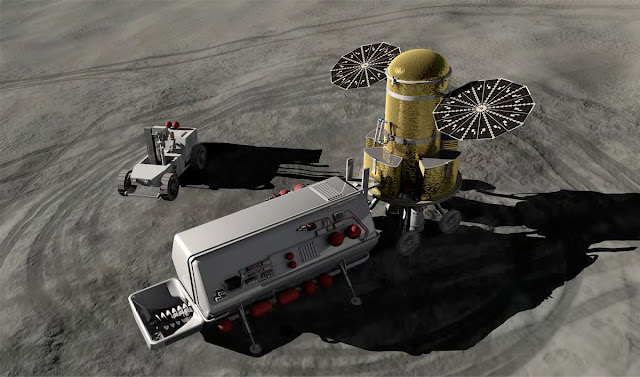 |
| 3D printing and ISRU are key to NASA's future plans. |
3D printing of metals and laser cutting of the HE can create the structures needed to implode the fusion fuel. It should be of similar difficulty as printing solar panels, and NASA already considers that a press-to-print process in the near future. This is the origin of the Wilderness adjective: pure fusion devices allow for ‘wilderness refuelling’ or In-Situ Resource Utilization, the same way chemical rockets can manufacture new fuel out of any mass of water they encounter.
How would these devices look like on a spaceship?
Let’s draft two designs for pulse propulsion spacecraft. The first one, the ‘Mars Circuit’ spaceship, aims to travel from Earth to Mars and back, and the second one, the ‘Saturn Circuit’ spaceship, will jet around the outer Solar System.
The Mars Circuit spaceship uses the Advanced EMG-MTF devices. It is a 100 ton spaceship carrying onboard power generation, radiators, life support system, habitation spaces and everything else needed for drifting through interplanetary space. It also has a payload bay that can fit 100 tons. Behind it is a magazine stack of fusion devices. The stack is 35 tons while empty. For a Mars mission, it is filled with 5064 units of half-size (250 kg) versions of the Advanced EMG-MTF devices, totalling 1266 tons. These provide a specific impulse of 753s. Utilizing them is a propulsion system of 108 tons.
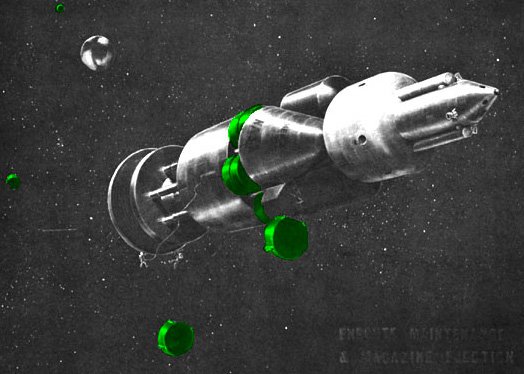 |
| A USAF Orion with its pulse unit magazines highlighted. |
This system includes a pusher plate, suspension arms and structural support that can handle 2 MN thrust per pulse. It is directly modelled on the propulsion section of the 10m USAF Orion design (although it would be overbuilt by modern standards). It can drop one pulse unit every 0.8s. Average thrust would be 2.5 MN.
Here is the summary for this spaceship:
This is not a zippy ship that can just take straight lines to its destination. It does however have enough deltaV to complete fast 120 day trips to Mars. It curves out of Low Earth Orbit and gently slows down into an orbit around Mars, without aerobraking. All neutrons are absorbed within the EMG-MTF units so this is not a radioactive hazard to its surroundings and won’t be ‘hot’ after use. It can directly approach space stations or other spacecraft, like the vehicles that will take the payload down to the Martian surface. Fresh pulse units can be manufactured entirely out of the resources available from the moons Phobos and Deimos. Within the 1266 tons of propellant, there would only be 37.8 grams of fusion fuel.
The Saturn Circuit spaceship is much larger and goes much faster by exploiting the power of SMES-EMG-MTF devices. It has 500 tons of onboard equipment, which include comfortable living spaces and a fully self-contained manufacturing facility. Payload capacity is 100 tons. Its magazine stack is filled with 100 kg pure fusion devices that contain 0.566 grams of fusion fuel and output 63.5 GJ thanks to SMES technology that stores 10 MJ/kg. Each unit provides a specific impulse of 3632s and a thrust of 3.56 MN. The average temperature of the plasma created by the use of each fusion device is 600,000 K.
.jpg) |
| The Mini-Mag Orion. |
This allows it to be harnessed by a magnetic nozzle at the rear of the spaceship. A 40 ton propulsion system (based on that of the Mini-Mag Orion) drops a total of 20,000 of these units at a rate of 1 per second.
Here is the summary for this spaceship:
This spaceship can really build up speed. Starting in Low Earth Orbit, it stops at Mars in 38 days, orbits Jupiter after 6 months or gets to Saturn in 1 year. It is not the fastest craft conceivable at that technology level, but it can be relied upon to connect the furthest planets without any initial infrastructure or external support. Even its longest trips are short enough that the 12 year half-life of tritium is not really a concern. It does all this using just 11.3 kg of fusion fuel so carrying an excess isn’t difficult.
At 3632s Isp and technically unlimited thrust, made possible by detonating pulse units more frequently or just using larger plasma explosions, there is a clear opening for high performance spacecraft with military potential.
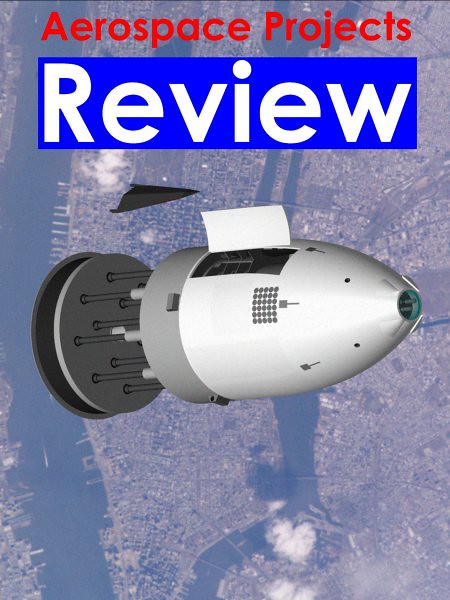 |
| The Orion Battleship, a 4000 ton design equipped with 20 Megaton nuclear missiles and naval guns. |
The combination of wilderness refueling and high performance makes wandering fleets, or more likely pirates, a realistic possibility. Stealth also becomes more effective if you do not need to heat up a nuclear reactor or ignite a fusion core to start maneuvering.
Superbombs
It is obvious that pure fusion devices have a real potential as weapons.
But by now, we hope that the numbers we have arrived at make it clear that they have nowhere near the destructive potential of existing nuclear warheads. They are thousands to hundreds of thousands of times weaker than a thermonuclear device initiated by a fission primary.
 |
| An F-35A testing the deployment of a B61 thermonuclear bomb. |
A B61 nuclear bomb with a yield of 300 kilotons of TNT can easily be carried by any aircraft with a hardpoint capable of more than 324 kg. Matching its performance with the wildest SOAF design would mean a warhead with a mass of 235 tons. It would barely fit inside the payload limits of the An-225, the largest cargo plane in the world. Using the Early EMG-MTF design would require 800,000 tons to reach that yield. That’s closer to the weight of all the US Navy’s nuclear aircraft carriers… combined!
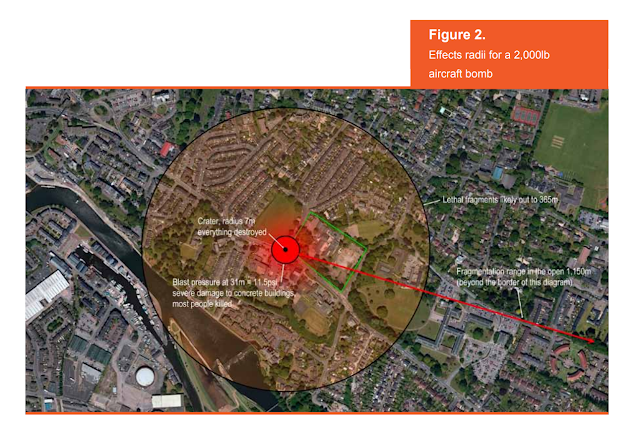 |
| The destructive radius of a 2000 lb bombs. |
It does not mean that there would be no consequences to the development of pure fusion devices. A plausible design with an energy density of 30 MJ/kg would be six times more powerful than simple HE. Real weapons are about 40% to 60% filled with HE, so it is practically a 12x increase in destructive potential. It would be a ‘superbomb’. By another comparison, the effect of a 907 kg (2000 lb) bomb could be matched by that of a 75 kg (165 lb) pure fusion device.
Warfare at the tactical scale has already known a significant shift in the effectiveness of bombs with the introduction of precision guidance systems. It allows large and bulky loads, like a Vietnam-era B-52D Stratofortress bay filled with 66 of the US Air Force’s 340 kg (750 lbs) bombs, to replaced by a precision strike by a JDAM-equipped GBU-12 at 227 kg (1000 lbs), of which fighter jets can carry several.
 |
| A Super Hornet with a full bomb loadout. |
Superbombs would cause another change in loadouts. The F/A-18 Super Hornet could be carrying 3600 kg of bombs and 1800 kg fuel for a long range strike mission. It would rely on other aircraft to protect it with their air-to-air missiles, and yet more to guide its munitions using equipment like Litening pods. With 30 MJ/kg Superbombs, its loadout could instead be 360 kg of bombs, 1800 kg of fuel and 3240 kg distributed between missiles, electronic warfare equipment, targeting pods or even more fuel. A single fighter could replace an entire squadron. It might even be able to hide its bombs inside internal bays to be able to maintain a stealthy outline, like an F-35B, while delivering the same power as an F/A-18 bristling with weapons.
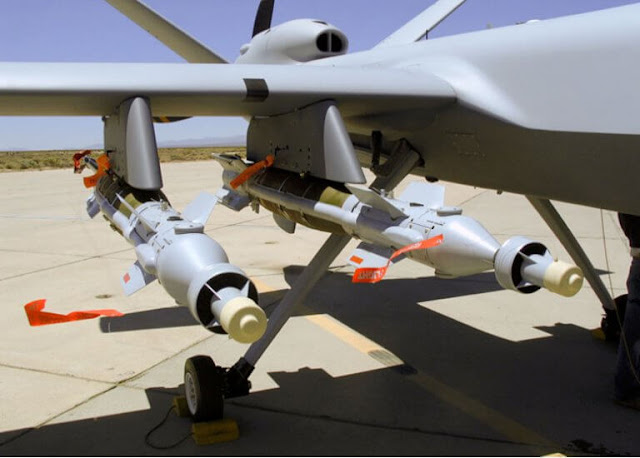 |
| An MQ-9 Reaper drone equipped with precision-guided Mk 82 bombs. |
Or, the expensive jets could be replaced by small drones, each only having to hold a few hundred kg of munitions. Pure fusion devices would make delivering destruction to far away targets even cheaper and easier.
A side-effect of the development of pure fusion devices is the access to ‘neutron bombs’. These are weapons that intentionally leak the radiation produced by the fusion reaction instead of trying to absorb it to maximize the amount of energy that becomes heat. The intention is to deal a lethal effect via penetrating radiation out to a further radius than the blast effect can manage.
The Early EMG-MTF device with its 2.52 GJ output would have a blast radius of 36 meters. An Advanced EMG-MTF yielding 16.8 GJ increases this radius to 68m. If these were converted into neutron bombs, they would deliver a lethal dose of radiation out to 272 meters and 512 meters respectively. It is enough to depopulate multiple entire city blocks. These radii are only reduced by about 50% when concrete walls stand in the way. Another consequence is that tank armor becomes much less useful. Today, a nuclear warhead that can kill a tank crew by radiation has to be close enough to destroy the tank itself by blast effect anyway. In this case, a near miss with a small superbomb is enough to deliver a lethal dose.
It is unlikely that the neutron effect can be scaled up to many kilometers (which would empty an entire city center with one hit) as air absorbs and scatters the neutrons after some distance, but it is still enough to create a frightening change of priorities during battle.
An invading force could hit populated areas with neutron bombs and rid them of any inhabitants, whether they are innocent civilians or potential defenders. They could then move in and easily hold it. No siege involved, no prolonged cries of the oppressed on social media and news channels. Just a single action that hands an entire city and its economic value, infrastructure and factories, mostly undamaged. Offensive actions would be immensely profitable. Defenders would have to pay an even higher price for letting any missile through their defenses.
The general result would be a gradual evolution of the state of warfare. Nothing as drastic as the invention of the nuclear weapon, far from disrupting the balance between nuclear-armed states, and not worthy of proliferation fears. Significant enough however to change what military planners worry about or aim for.

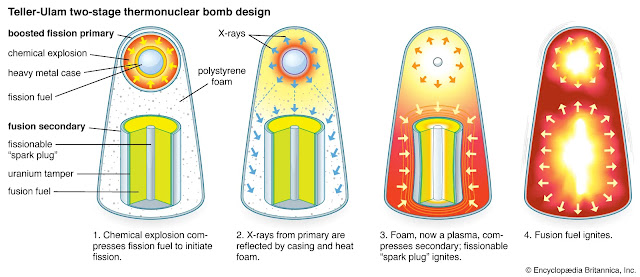

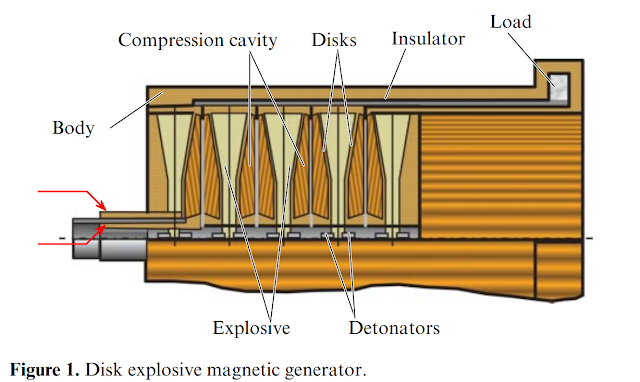
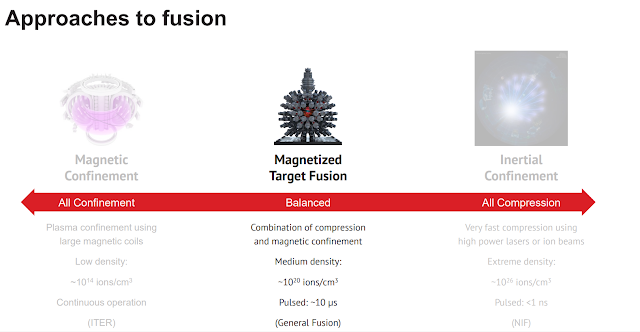

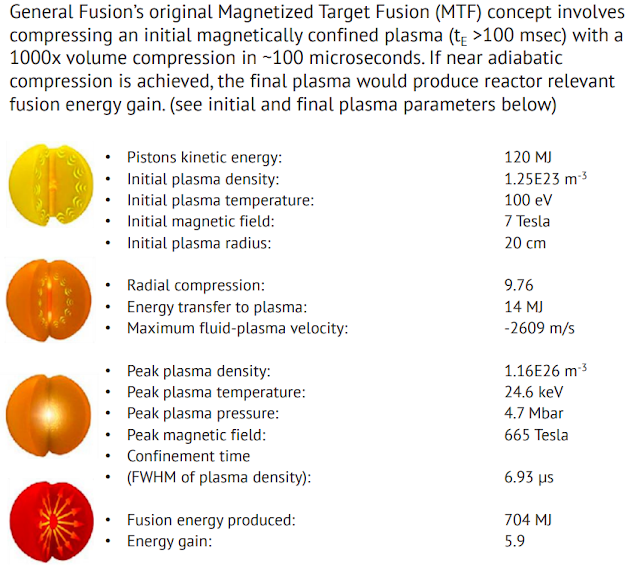
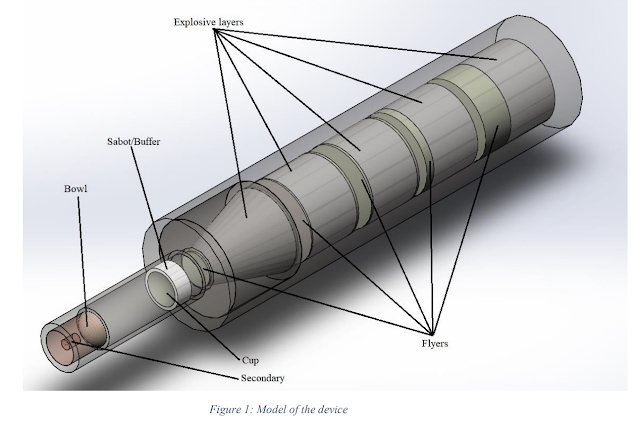




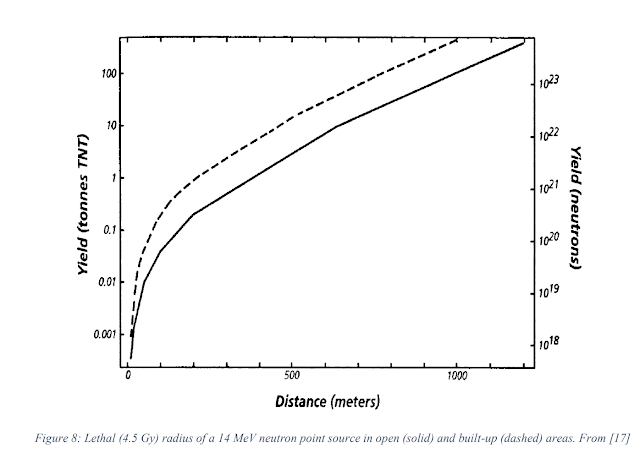
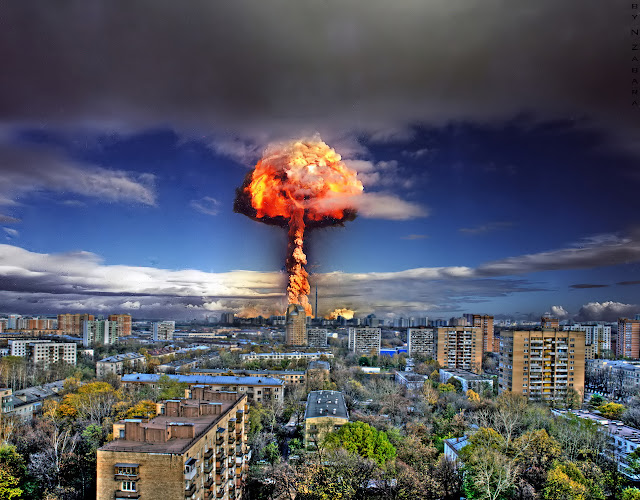
Another great blog post! I love reading these. Could this system do single stage from earth surface to mars surface and back?
ReplyDeleteHello and thank you!
DeleteYes, this could definitely make such trips. It has the thrust and Isp to do it.
The deltaV requirement for Earth surface to Mars landing, with no aerobraking or gravity assists, is 16.5 km/s. If we used the Advanced EMG-MTF devices with 753s of Isp, then the mass ratio becomes a cumbersome but manageable 9.33. If we used the better SMES-EMG-MTFs with 3632 of Isp, then the mass ratio is an easy 1.58. It would become easy to land on Mars and even return for a powered Earth landing.
Carlo Rubbia's Americium 242 concept is of interest to me. Chemonuclear blasts best for sample return? Supercharged mass drivers. SMES reserved for Dyson Harrop powersats maybe? -publiusr
DeleteThe Americium 242 greatly reduces the minimum critical mass for a reactor or fission device. It is not really relevant to a pure fusion device that does not want to use any fissile material at all.
DeleteAlso, a pulsed unit like the one the regular Orion drive uses only has about 2-3% of its mass dedicated to fissile material. Swapping out uranium for short-lived and ultra-expensive Americium 242 is not going to help much!
Very interesting post. Aside weapons and propulsion, those devices could be used for variety of peaceful nuclear explosion projects. Without nuclear fallout their biggest downside is gone.
ReplyDeleteAs for military use, while they would be impact, I think that much of it would countered by increasing prevelence of point defence and anti-missile systems. Cities could be harden against neutron bombs (lining wall with polythene).
Even then fallout-free neutron bomb would still be a warcrime. While every military conflict involves warcrimes to some extent, this crosses territory from intimidaton to genocide.
Thanks!
DeleteThese could be used in peaceful projects. They wouldn't be 100% safe, as they do release enough neutrons to activate rocks they are directly in contact with, but that becomes a non-issue after a few days. Contrast this to the radioactive material left behind by fission nukes that would contaminate an area for decades...
Military potential is harder to speculate about. Advances in point defense and missile interception systems will happen, and superbombs could help with that. An anti-missile missile could have a much smaller warhead thanks to a pure fusion device, so you could put a lot more missiles up in the air to intercept incoming projectiles for the same cost.
Also, neutron bombs are really effective at neutralizing conventional nuclear warheads. Pure fusion devices have the added bonus of not showering the city you are defending with radioactive fallout after their job is done.
1. There would in fact be significant fallout, in the form of neutron-activated material from the bomb itself and nearby material kicked up by the explosion (or drawn into the mushroom cloud by an air burst).
Delete2. You are very probably underestimating the problem of neutron activation of the area around the blast, especially for deliberate neutron bomb strikes. As I recall, this was actually considered a positive feature for anti-tank use, because it meant that the enemy can't just pull out the dead bodies and re-crew the tanks with fresh meat (unless the spare crews are willing to die horribly of radiation poisoning, anyway). Neutron-bombing a city, even with pure fusion bombs, would probably turn that city into a radioactive waste dump for quite a while - although some attackers might consider that as a feature rather than a bug.
3. Even if you did have some way to magically kill everyone in a city with only light damage and no contamination, then you would still annihilate the entire economy and labor force (skilled and otherwise) and basically turn a functioning city into a well-preserved ruin. Best case scenario is if the attacker is a bunch of Nazis who actually have tens of thouosands of Lebensraum settlers prepared and waiting to immediately repopulate those ruins, and even then you would have a massive logistical undertaking to actually restart a functioning society and economy
4. The relatively low yield per kg of pure fusion bombs as compared to Teller-Ulam warheads would become irrelevant if the pure fusion device could itself be used to ignite such a warhead without needing any fissile material.
Edit to the fourth point:
DeleteYou say that the temperature and pressure achievable from a pure fusion device are still significantly less than you get from a fission primary, but I would think the relevant question is more one of whether the fusion device could generate enough of an x-ray blast to use for a radiation implosion of a larger fusion stage. My understanding is that the fission primary is really just a giant x-ray flashbulb, and all other energy transport processes are so slow compared to radiation transport that they play no role in igniting the secondary. Or at least they aren't supposed to if your bomb is designed properly.
I don't have an answer for you right now but I can say this:
DeleteIn Winterberg's own fusion ignition designs, the energy of the HE has to converted into 'higher quality' energy such as intense electrical currents or imploding magnetic fields for it to be able to achieve ignition. The blast from a pure fusion device would have to be converted into this 'higher quality' energy if we want it to ignite a larger fusion stage - which might require equipment (explosive flux generators?) scaled up the gigajoules energy we need to handle.
The specific form of energy used in a Teller-Ulam bomb is high-intensity x-rays, which are produced by blackbody radiation from the primary. The immediate question is what is the effective radiation temperature of the pure fusion blast in the first few tens of microseconds (before the thing blows itself apart), which determines both peak emission frequency and total flux.
DeleteAt least some pure fusion designs, like the MTF variants, explicitly rely on producing similar temperatures as a Teller-Ulam bomb, though only in a very small area in the center of the device, so effective surface temperature still depends on fusion gain vs. amount of unavoidable surrounding material.
You could also use the fusion neutrons to fission a uranium or plutonium tamper. Fusion neutrons are energetic enough for U-238, though reactor grade U or Pu would work even better. The result would be similar to a classical boosted fission device, releasing potentially far more energy from tamper fission than from fusion.
The fission-fusion idea does seem like the most productive option but it might run counter to the whole 'no fissiles needed' aspect of these HE-ignited devices.
DeleteI wonder if this would make a PACER type reactor more realistic. One of the biggest issues, among many, with PACER was the cost of the fissionable material and accumulation of fissionables and fission products in the reaction chamber. WIth pure fusion that simplifies things.
ReplyDeleteI doubt it.
DeletePACER works only because of the enormous potential energy contained in fissile materials. A pure fusion device with 5x the energy content of regular HE isn't comparable.
Also, using HE to ignite fusion reactions when you have a large stationary installation with no mass or size constraints is unwise - you could just use a 'conventional' ignition method like lasers or magnetic fields.
The SOAF design at ~2kt is quite a lot more than simple HE in terms of energy density. Would it be possible to add a second stage to some of these designs to boost the yield? Use a wimpy pure fusion first stage to ignite a bigger second stage.
ReplyDeleteYes, second stages and burn waves could be possible. However, they are rather speculative and the temperature/pressure you achieve with a pure fusion device is far lower than what is available from a fission primary.
DeleteSo, I think it can be done but it will be very difficult.
Hmm...
ReplyDeleteI'm on a train of thought: any approach that can squish-and-heat a drop of fusion fuel to ignition is going to be more than capable of crushing a small and normally subcritical pellet of uranium (say, U-233) into a critical density. Squeeze hard enough, and you can make sure a greater proportion of the uranium fissions, thus negating the efficiency penalty imposed by the small mass. It would also be a lot easier to do than fusion, to the point where even using uranium fission in a gradient field imploding liner type design would be plausible for current technology (and that's not much of a stretch, since this concept is similar to the old gun-type bombs; just with railguns instead of chemical barrels propelling the armature, and magnetic fields doing the squeezing instead of inertia).
Such a device would still be subcritical normally, so little potential for direct use as a bomb. Wilderness refueling would, however, not be possible... unless you want to build a design that uses the small uranium blasts as an igniter for fusion :).
This is true. Winterberg has many 'microfission' concepts using advanced compression schemes to ignite smaller and smaller pieces of uranium. It is not however the focus of this blog post, though it deserves its own write-up.
DeleteHow would the performance of the Saturn circuit design change if we were to use the SOAF devices while keeping the mass fractions the same? I don't follow how the performance was calculated exactly. Would we just get 330 % more delta-v? Or would the acceleration change as well due to the higher yield of each bomb?
ReplyDeleteHere are the stats with the Saturn Circuit spaceship using SOAF devices:
DeleteSaturn Circuit spaceship
Payload: 100 tons
Dry mass: 560 tons
Propellant mass: 2000 tons
Total mass: 2660 tons
DeltaV: 128.5 km/s
Acceleration: 0.14g (full) to 0.55g (empty)
The SOAF devices have 9400s Isp, which is 2.58 times more than the SMES-EMG-MTF devices and their 3632s Isp. That is where the huge increase in deltaV would come from. They would be sized to deliver the same thrust so we expect the same acceleration.
what do you think about concept hybrid nuclear drive it combination solid fuel thermal nuclear engine with an impulse engine
ReplyDeletearticle in polish
https://kosmonauta.net/2010/07/impulsowe-silniki-jadrowe/
It sounds like it is describing this concept: https://en.wikipedia.org/wiki/Pulsed_nuclear_thermal_rocket
DeleteNot exactly. The article presents the concept of throwing balls of fissile material into the reactor, which, when bombarded by neutrons from the reactor, explodes, increasing the temperature of the propellant (hydrogen) and thus the specific impulse of such an engine
DeleteExcellent post! Though it is per usual.
ReplyDeleteJust a few question:
- You mentioned that pure fusion devices may be useful for stealth ships as they don't need to start up a reactor. However, I think that igniting a miniature sun right behind you may be equivalent to screaming, "HERE I AM!"
- The use of magnetic cones to direct the plasma of the charge for more dv is possible. I'm wondering is if such an arrangement can be used for an Earth-surface to Mars-surface circuit?
- Speaking of propulsion, what would the performance be for nuclear charges (Casaba Howitzer, NEFP, NHEAT etc) be?
- Finally, a dumb question to round things off. Can a thermobaric explosion be used to trigger a pre fusion reaction? Though I can already guess the answer to that.
Hi!
DeleteHere are my answers:
-Yes, you would be highly visible while maneuvering. However, you would not give off radiation or heat before or after the maneuvers. A nuclear reactor for example would emit decay heat and neutrons for many hours after use.
-Using magnetic nozzles inside the Earth's atmosphere is unlike to work. You can use a simple pusher plate however, like Orion, inside Earth's atmosphere.
-Using pure fusion devices as a shaped nuclear charge would be possible. It would just perform about 100x to 1000x worse than a regular nuclear device.
-A thermobaric explosion comes from the deflagration of a fuel-air mixture. There is no air in space!
Interesting, thanks for the replies!
DeleteAlso:
- When I asked if a thermobaric explosion could set of a pure fusion device, I just thought that it would be in atmosphere for the reason you stated. Obviously, I should have been more clear!
- If nuclear shaped charges that depend on pure fusion are comparatively so weak, would there be any application for such charges? And I assume a casaba howitzer for propulsion are still viable if I'm not mistaken?
- While I do agree that heat is not as much of an issue for stealth craft with pure fusion drives, I'm still skeptical about the viability of such craft as it would illuminate the entire craft during maneuvers, making more difficult or even impossible for the stealth ship to reposition itself without being spotted. Something the curved bell nozzle was designed to solve.
A thermobaric device would quickly lose its effectiveness at high altitudes. If it is providing enough pressure to ignite a fusion device at sea level, it might not work at all by the time you reach 20 km+ and wouldn't even ignite in the thin air for 50 km+
DeleteThat's no way to reach space!
By nuclear shaped charges, I do include Casaba Howitzers.
For stealth: the advantage of a pure fusion drive is that it does not need to warm up before maneuvering and has practically no decay radiation after turning off. A nuclear thermal rocket would remain 'hot' for several hours to days after being used while leaking a trail of neutrons that anyone can track. For the perspective of a telescope, a pure fusion drive looks like a short burst of nuclear flashes and then nothing. It would be very hard to work out a trajectory, velocity and potential destination, let alone derive the mass and nature of the stealth craft!
Could you use thermobaric bombs to help get a project orion rise through the lower layers of the atmosphere and then switch to nukes or an equivalently poweful bomb once the air thins out?
ReplyDeleteIf so I was thinking it would be ideal, since thermobaric bombs have no radiation, and the farther away the radiation occurs from the ground generally the better.
I was told elsewhere that fuel air bombs tend to bigger than nukes so not only would the hole they are shot through need to be bigger but the the orion could carry less of them compared to nukes as well... so that is the only drawback besides one more.
Namely that they are bad for longterm storage I was told. Likes to go boom if you do not explode it in a reasonable time. Sitting on a spaceship for months may be a bad idea.
What are your thoughts matterbeam? I was actually thinking on a spaceship that mimics scifi spaceships that can take off at will from a planet and return. IT would be a belly lander Orion with belly VTOL chemical rocket thrusters, a rear pusher plate, and the use of thermobaric bombs to get the ship past the low atmosphere, switching to nukes or their equivalent afterward to reach orbit.
Sounds quite possible in practice... or at least so in my head anyway LOL.
Yes, you can use thermobaric bombs as a source of thrust. However, I am certain that their performance is very low. For one, they depend strongly on ambient air to work. This means they suffer from high altitudes and might not even allow for rapid pulses because you have to wait for fresh air to arrive and for new fuel to disperse evenly after each use. Another factor is that they do not produce a sharp shockwave like HE but instead create a large fireball. Hot air expands much more slowly than gases from a high explosive, so your specific impulse will be terrible.
DeleteI would instead consider using simple HE without the fusion devices to avoid radiation for liftoff. You'd still get 5-15% of the regular fusion device's energy, which you can compensate for by pulsing more frequently.
Question, how effective would any of these be for use as casabas when compared to fission devices (if they can be used as casabas to begin with)?
ReplyDeleteA good first estimate is that the plasma velocity from a Casaba Howitzer based on a pure fusion device will be similar to the exhaust velocity of a pulsed propulsion unit based on the same fusion design.
DeleteFrom our list, we see a maximum of 9400s or 92 km/s. This is similar to the original Casaba Howitzer design, so we could expect similar performance.
Perhaps you can do a post on low mass radiation shielding one day?
ReplyDeleteSince of all things in scifi it is the most damning, until we somehow get effective lighter weight radiation shielding then any spaceship is a cancer death trap.
I reckon their are ways to do it that di not involve super thick (6 foot thick walls of concrete) to keep out tge cancer rays.
I always think in future times that certain engineered materials could advance to the point where they could both absorb and reflect the entire EM spectrum including pesky gamma rays.
I disagree. Shielding is a mass penalty, and that penalty is only significant if you have weak chemical-fuelled spaceships that cost tens of thousands of USD per kilogram to put into orbit. If you have scifi ships shooting around the solar system, then the penalty of shielding is small to insignificant.
DeleteAlso, the only way to get rid of that mass penalty is to use powerful active shielding, which projects magnetic fields that deflect most (not all) radiation. We do not have those yet, but we would if our spacecraft could consistently deliver several kW of surplus electricity.
6ft of concrete is only necessary if you are facing the business end of a high power particle accelerator. The space environment is not like that.
Well I was thinking of project orion SSTO belly landers with pusher plate tail ends.
ReplyDeleteNot the less realistic scifi torchship. The main advantage of external pulse propulsion is that it can harness higher energy for it's propulsion precisely because it occurs outside the spaceship.
From what I have read and posts by folks who love to calculate the theoretical, a torchship that was on par or better than project orion would likely be larger still, since getting rid of high waste heat levels involves enough propellant mass leaving the engine bell to carry it away.
The end result is a spaceship with a giant fuel tank and nozzle that is mostly fuel tank.... seems like the tyranny of the rocket equation means that you will always have a higher percentage of cargo space dedicated to propellant than anything else. I reckon external pulse propulsion could have better 'propellant' to cargo ratios, since the whole point of a spaceship is to ship stuff other than propellant.
Magnetic fields deflect radiation by deflecting what are called cosmic rays, which are actually fast moving tiny particles that cause radiation when they strike anything in space.
Any thing that is just an actual electromagnetic ray it won't work on as far as I know.
Magnets have no effect on deflecting light rays as far as I know.
Numbah one: Any fusion reactor or device is a proliferation risk because its neutrons can produce Pu-239 and U-233 from Nat U and Nat Th.
ReplyDeleteNumbah two: General Fusion is gigaretarded and high school educated. Plasmas have practically infinite thermal conductivity and as soon as that liquid liner comes into contact it cools. Also the liner is too slow.
Numbah three: That's terror.
It's really amazing that nuclear pulse propulsion *still* has tough-to-beat performance even with the handicap of not having ready access to fissile materials. Good post.
ReplyDeleteThank you!
DeleteYeah, it was eye-opening to me too.
I'm curious as to the what level of technical expertise and capital expenditure is likely to be required if/when pure-fusion devices are developed. Could they be developed by only a very few nation states (similar to today's nuclear powers), by disgruntled high school students, or somewhere in-between?
ReplyDeleteKeith Halperin
Hi Keith.
DeleteIt's difficult to assess how difficult this sort of device will be. The concept is pretty simple: translate HE energy into compression of fusion fuel. With an advanced 3D printer, you could make it at home. But getting it perfectly right and ironing out all the kinks is going to be very difficult - you are facing some of the same challenges that NIF and the many fusion startups are struggling to solve despite billions of dollars in funding and decades of effort.
Indeed. Perhaps it will always be 25 years in the future...
ReplyDeleteOhh, they call me Mr Huff and Puff, but I’m not in the huff, and I’m not a puff … I just want to make sweet love, to her.
ReplyDeleteCould pure fusion bombs reuslt in a revival of the project pacer concept? I.e. build a fusion reactor by dropping bombs into an underground cavern filled with water. As I understand it the isues were primerily economics and politics, but the whole setup needed to be big due to the power levels of the bombs. I shudder to think of ecomies of scale for nuclear weapons manufacturing, but once one has a viable design, the mass production seems quite doable. So, the crux of the matter is, it it reasonable to assume that the production cost of an SOAF device could be lower than the price of energy it releases?
ReplyDeleteYes, that's right.
DeletePure fusion devices can be made smaller and would not release radioactive metals like fission bombs. That makes them perfect for the PACER concept. Other than cost, the problems it had were finding underground caverns big enough, and dealing with radiation leaks. Pure fusion devices would solve both these problems.
I thought you said in an earlier comment response that the kinds of devices discussed in this post don't really have any advantage over the likes of ITER or NIF if you are building a large ground-based powerplant with no size or mass constraints.
DeleteIf it is used as an auxiliary engine like a maneuvering thruster, is it also a fusion rocket? It also appears that certain types of rockets only initiate fusion reactions while they are operating. If the spacecraft has so much power consuming equipment on board that it requires energy other than thrusters. Would it still be necessary to get energy from the thrusters to sustain the fusion reaction or would it be necessary to get the energy to sustain the fusion reaction from the energy supplied to the rest of the spacecraft?
ReplyDeleteIn the 'pure fusion' devices, all the energy needed for ignition is already stored in the High Explosive each devices contains. There is no additional power input required.
DeleteGreat as always.
ReplyDeleteDo wish you’ld have touched on impact fusion like First Lights reactor design. It seems like a great alternate design for a Orion drive needing no fission trigger, and very scalable.
Thank you.
DeleteFirst Light Fusion needs a powerful linear accelerator to drive up the fusion fuel to impact velocities sufficient for ignition. It takes capacitors the size of a building to store the necessary energy to do that, and then there is the equipment needed to recover that energy from the fusion reaction to recharge those capacitors.
The pure fusion concept described in this blog post relies on High Explosive with a very high energy density. Of course, the challenge is in converting that energy into a form that is fast enough to ignite fusion fuel...
Love your work! I have a couple of questions:
ReplyDelete1. I saw you mentioned stealth aspects to another commenter. Wouldn't the other systems of the ship (life support, residual heat, etc) produce enough of a thermal signature to negate the stealth aspect? I saw your helium steamer post, but this design is far from that.
2. What would a military version with much higher acceleration look like in terms of specs and design?
1. You are correct, you need a proper stealth ship design. The idea here is that pure fusion can help staying cool and quiet during the drift phases between engine burns.
Delete2. A military version would just use a fission stage to massively increase the thrust power and specific impulse, compared to a HE-ignited fusion engine.
What do you think about the muon-catalysed fusion engine concept where muons are produced from ultra-dense hydrogen
Deletehttps://www.youtube.com/watch?v=9jAUXuL-6oc
https://www.researchgate.net/publication/341601815_Future_interstellar_rockets_may_use_laser-induced_annihilation_reactions_for_relativistic_drive
We have never produced or tested Ultra Dense Hydrogen so this is entirely theoretical...
Delete"no prolonged cries of the oppressed on social media and news channels"
ReplyDeleteOutside of the lethal range of radiation you'd have a bunch of people who get severe radiation sickness, not to mention cancer, but don't die immediately.
That would be a PR nightmare. Imagine the cries of people literally falling apart from radiation sickness. Imagine the reparations you'd have to pay for cancer patients.
There is no reason to use this in a civilian zone other than genocide. It would not be strategic at all.
Idk if you answer comments from two years after the fact, but if so: What would the effect of using a deuterium-helium 3 fusion reaction, instead of a deuterium-tritium fusion reaction, in the pulse units be? If I remember correctly, a deuterium-tritium reaction produces slightly less energy overall than a deuterium-helium 3 reaction, and far more of it (80%, I think?) is turned into neutrons than for a deuterium-helium 3 reaction, so would this improve performance?
ReplyDeleteHi!
DeleteDHe3 fusion would indeed a lot more energy in the form of charged particles instead of neutrons. Charged particles are a lot easier to stop than neutrons, so almost all of them will be absorbed within the fusion bomb walls and converted into useful heat, rather than flying out as penetrating radiation.
So, a DHe3 fusion fuel could deliver a lot more 'useful' energy than a DT fuel. However, it is much harder to ignite than DT and the fusion gain ratio (ignition energy vs output energy) is much smaller too.
https://nickhawker.com/category/fusion-physics/
So your DHe3 charge might require so much more HE to ignite than its average MJ/kg energy density is lower than a DT charge! The only benefit is that it is 'cleaner' with less deadly radiation being released.
Ah, okay. That makes sense, thank you!
DeleteIncidentally, would it be worth making the pulse units 'shaped charges' a la Project Orion?
Definitely, if your aim is propulsion and not weapons.
DeleteIf Buhler's propellantless EM drive is actually working and the reading of 1 g of thrust was accurate, would it replace the pulsed fusion drives described on this page as the fastest and most effective ways to travel?
ReplyDeleteA physics-breaking propellantless drive that can push a spaceship at 1g will replace all space travel, all air/ground/sea travel, all motore and energy production, and will be cracking open planets and extinguishing stars in 1 month and 1 year respectively.
Delete